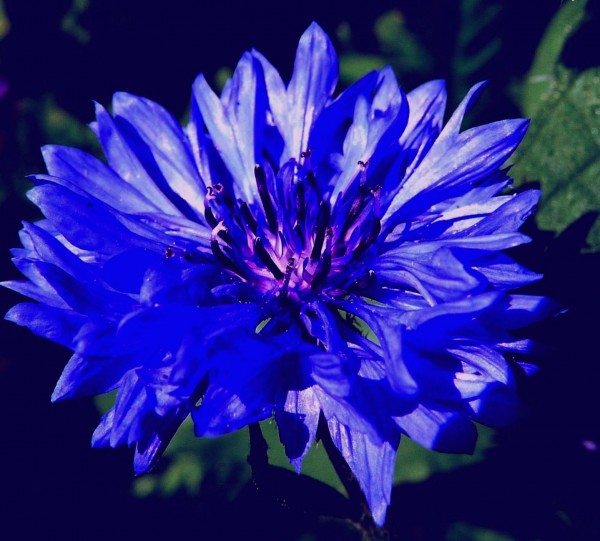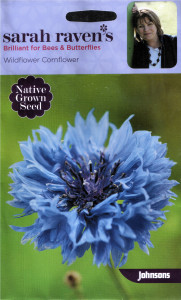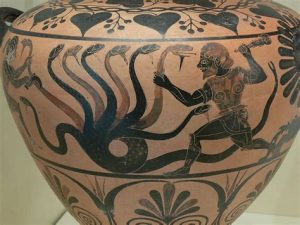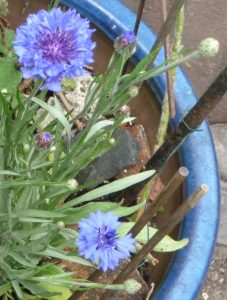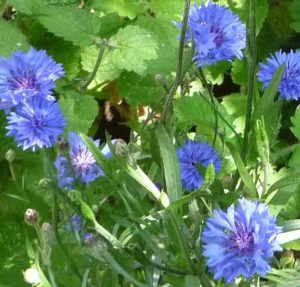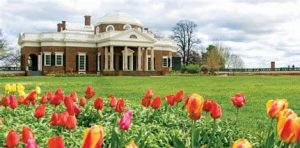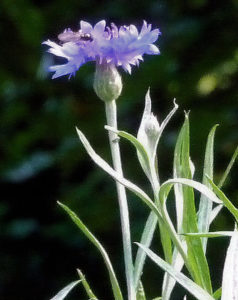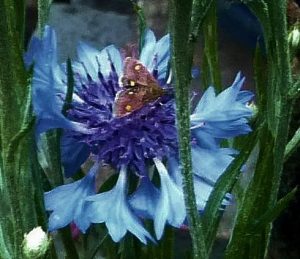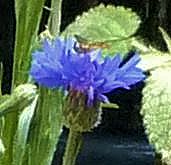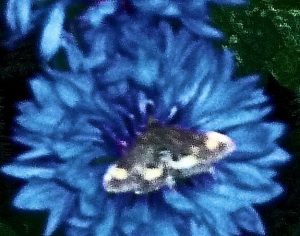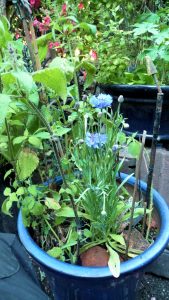CORNFLOWER (Centaurea cyanus)
Temperate Europe
An annual wildflower loved by gardeners & painters of medieval manuscripts, Centaurea cyanus is a former weed of the cornfields in the UK. Now it can be found on roadsides & hedgerows in Central & Southern England.
The Cornflower likes full sun & will grow from 1 to 3 feet tall ( 75cm ) in soils that are sandy, gravelly or poor as long as it has good drainage. Leaves are blue-grey & downy; flowers are an intense BLUE. From June to midsummer these striking BLUE flowers bloom like jewels.
Flowers are edible, with a taste similar to cucumber.
Deadheading the flowers when they have finished, up to their third leaves, persuades the plant to produce more flowers.
How to Grow Cornflowers from Seed – YouTube
Historical
This wildflower was brought to Britain in the Iron Age.
‘…the Cornflower is found in Neolithic beds at Edinburgh with other weeds of cultivation and flax… Bluebottle is a cornfield plant, always coming up spontaneously in cultivated fields or on waste ground, or in gardens, being associated with such plants as Stork’s Bill, Common Mellilot, Chicory, Viper’s Bugloss, Yellow Toadflax, and other casuals… Ink has been made from the juice of the flowers, which stains linen blue.’
A R Horwood, British Wildflowers in their Natural Haunts, The Gresham Publishing Co Ltd, London 1919.

Cornflower, J N Fitch, Wildflowers of the British Isles in their Natural Haunts, Horwood, Gresham Publishing Co Ltd, London 1919.
In the book ‘Sylva Silvarum’, written in the seventeenth century by Francis Bacon (1561-1626), the cornflower is described as a flower which is seldom or never seen in places other than among corn.
In medieval times, the flowers were woven into wreaths to be worn on the head.
The cornflower came to symbolize love, fertility, hope, anticipation, patience, elegance, delicacy, refinement and single blessedness.
In England girls wore cornflowers to show that they were eligible to marry. 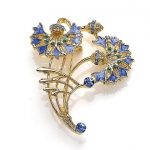
Maddie Forbes, online website Pansy Maiden – Cornflower flower meaning, symbolism, and colors
The Cornflower has close associations with political parties in several European countries. Edward Alleyn (1566-1521), proprietor of Marlowe & Shakespeare’s Rose Theatre on Bankside, London, was especially fond of Centaurea cyanus. At the school he founded, Dulwich College, every student wears a buttonhole of Cornflower on the annual Founder’s Day. https://en.wikipedia.org/wiki/Centaurea_cyanus#External_links
Historical, Other Countries
Cornflowers were found in Tutankhamun’s tomb in Egypt. Despite being over 3,000 years old they had lost very little of their colour.
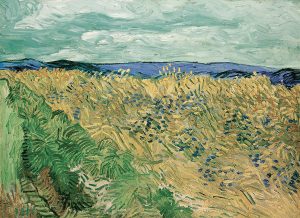
Wheat Field with Cornflowers, 1890, by Vincent van Gogh – Impressionist, Dutch painter in French field
The French wear Cornfowers much as we wear poppies: as a symbol of remembrance. It is known as the Bleuet de France.
Cornflower used to be taken against poison, plague, wounds, fevers and inflammations. ” Plantlifehttps://www.plantlife.org.uk/uk/discover-wid-plants-nature/plant-fungi-species/cornflower
.
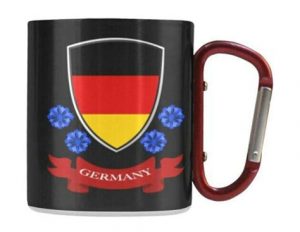 The Cornflower is a source of blue dye; in Russia this dye is added to vodka to give it a blue tint
The Cornflower is a source of blue dye; in Russia this dye is added to vodka to give it a blue tint
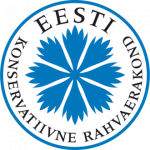 National flower of Estonia and Germany (Prussian Blue).
National flower of Estonia and Germany (Prussian Blue).
Legendary
Cornflower was named centaurea “from the legend of the centaur Chiron, who was wounded by an arrow poisoned with the blood of the Hydra. He covered his wound with its blue flowers, which have retained their healing properties.” Green Magic – Flowers, Plants and Herbs in Lore and Legend, Lesley Gordon, Ebury Press, 1977.
According to Greek myth, Achilles was wounded with a poisoned arrow (by Herakles), and his wound was healed by applying cornflower plants. The poison came from Hydra, in Greek mythology usually imagined as a huge poisonous water snake, but at that time interpreted as a giant slug. In Christian symbolism, slugs were associated with the devil, hence the remedy, cornflower, became a symbol of the Queen of Heaven, Mary, and Christ, and was often depicted in paintings of the Middle Ages and the Renaissance, frequently seen in Christian frescos. Journal of Experimental Botany, Oxford Academic, Riklef Kandeler, Wolfram R. Ullrich, 2009.
‘One of the cornflower flower names is derived from the specific botanical name of the flower, cyanus. According to the legend, the Greek youth Kyanos worshipped the goddess Flora. He was always gathering blue cornflowers to make garlands and place them on her altar. He even wore clothes in the same blue shade as the cornflowers which he admired. He rarely ever left the fields, and one day he was found lying dead in a cornfield. Around him, the blue cornflowers continued to bloom. Flora named those flowers after him, in honor of his devotion and veneration.’
There is a Russian legend : A young man, Vassili, was lured onto a cornfield and metamorphosed into a cornflower by a possessive nymph called Russalka. In Russian, the word vassili is etymologically linked to the local name of the cornflower, Basilek (the flower of Basil). Maddie Forbes, Pansy Maiden – Cornflower Flower: Meaning, Symbolism, and Colors, online website
Edible
‘The attractive flowers of cornflower have a slightly spicy, clove-like flavour with a subtle sweetness. Cornflower petals look wonderful in salads. Use torn petals as a garnish, or whole flowers in fancy drinks.The flower buds contain: biotin, folate, vitamin C, calcium, protocyanin, and flavones.’ Cornflower: Pictures, Flowers, Leaves and Identification, ediblewild ood.com https://www.ediblewildfood.com/cornflower.aspx
Medicinal
Antibacterial, anti inflammatory, antiseptic and astringent…
‘Cornflower’s medicinal properties were first mentioned in the 12th century writings of Hildegard of Bingen.’ Cornflower – Herbal Encyclopedia – Mozilla Firefox
” A water distilled from Cornflower petals was formerly in repute as a remedy for weak eyes. The famous French eyewash, ‘Eau de Casselunettes,’ used to be made from them. Culpepper tells us that the powder or dried leaves of the Bluebottle is given with good success to those that are bruised by a fall or have broken a vein inwardly.
‘it is a remedy against the poison of the scorpion and resisteth all venoms and poisons. The seeds or leaves (or the distilled water of the herb) taken in wine is very good against the plague and all infectious diseases, and is very good in pestilential fevers: the juice put into fresh or green wounds doth quickly solder up the lips of them together, and is very effectual to heal all ulcers and sores in the mouth.’
Other Uses
The expressed juice of the petals makes a good blue ink; if expressed and mixed with alum-water, it may be used in water-colour drawing. It dyes linen a beautiful blue, but the colour is not permanent.
The dried petals are used by perfumers for giving colour to pot-pourri. “
Maud Grieve, A Modern Herbal, Harcourt, Brace 1931.
Health Benefits of Cornflower Honey
This website, BEES WIKI, looks into the medicinal properties of Cornflower honey & how the bees make it. https://beeswiki.com/cornflower-honey/
Organic honey made from Cornflowers retains its medicinal properties when left raw, unheated, unfiltered & unpasteurized. When honey is pasteurized the therapeutic enzymes are lost. As of 3rd August 2022, organic Cornflower honey could be ordered online from:
 Bees Canteen (Orpington), a small eco friendly family brand with over 100 years of tradition. ‘Our beekeepers not only care for the bees but also respect them’. https://bees-canteen.co.uk
Bees Canteen (Orpington), a small eco friendly family brand with over 100 years of tradition. ‘Our beekeepers not only care for the bees but also respect them’. https://bees-canteen.co.uk
Sweet Honey Co – ( Polish honey ) https://www.sweethoneyco.co.uk.> product-tag > cornflower-honey
Etsy UK, a small business offering raw honey straight from the beehive, from the clearest & most ecological region of Warmia & Mazury in Poland. Honey is 100% natural, unsweetened, unheated, unpasteurised. https://www.etsy.com/UK/listing/859656376/raw-cornflower-honey-organic-honey
Siberian Fine Foods Nectar Agro Farm, offering exceptionally healthy products from the heart of Siberia. (Blimey Horseradish Vodka!) Our apiaries are located in the environmentally friendly areas of the Krasnoyarsk Territory. No food coloring or preservatives. https://siberianfoods24.ru/en/vasilkovyij
Various bees, flies, day-flying moths such as the Six-spot Burnet & other insects frequent the flowers of Centaurea cyanus. https://beehappyplants.co.uk/bee-plants/centaurea-cyanus/
The Disappearing Cornflower
Wikipedia says this wildflower had been found growing on 264 sites in the UK; these have now dwindled until it is to be found on only three sites.
Conservation charity Plantlife lists the Cornflower as one of 101 species it would like to see brought ‘Back from the Brink’.
” The Cornflower has declined dramatically in the wild in the last 60 years and fields full of these flowers were last seen between the wars. Its decrease is due to modern agricultural practices, such as increased use of herbicides and fertilisers, the development of highly competitive crop varieties, the destruction of field-edges, the demise of traditional crop rotations, improved seed-corn cleaning and the conversion of marginal arable land to pasture. These factors continue to be a threat to its future. The decline of the Cornflower illustrates what has happened to many of our wild flowers over the last 60 years. Plantlife
Can be Invasive
While the Cornflower has been systematically eradicated from the UK, it has found a root-hold elsewhere in the world, enough to have it listed as ‘invasive’.
Presidential Connections
‘European flower markets influenced Thomas Jefferson’s garden choices, and the choices of all Virginia colonial gardeners. The cornflower or Bachelor’s Button, a native European species introduced into many a colonial garden, including Thomas Jefferson’s garden at Monticello, subsequently escaped into the natural environment and became established throughout the United States.
The bright blue flowers explain the plant’s ornamental popularity. Additionally, it brings with it a medicinal and food source history. Today, it can be classified as either a weed or an ornamental, depending on its growing location.’
Virginia Wildlife and Nature Stories -Mozilla Firefox
It prefers highly disturbed areas like prairies, (historically, the sustaining life force of a prairie was fire, which wipes out much of the herbaceous growth) allowing new species to colonize the area. It has been introduced as an ornamental species in North America, and parts of Africa and Asia where it is considered an introduced species (locally invasive in some areas). In Australia it is a pest species. Prickly and Bitter: Remembering JFK with Cornflowers, Botanical Musings, Mozilla Firefox.
This invasive species map of the USA for Cornflower Centaurea cyanus shows which states have reported a problem. It appears that in virtually every state the plant can manage, somewhere, to dominate indigenous species. North or South of the Mason-Dixon Line, in extreme heat or cold, coastal or heavily populated – it has adapted.
Other names: African Corn Lily, ANber, Aciano, Azulejo (Spanish), Bachelor’s Button, Barbeau, Basket Flowers, Blaklint (Swedish), Blavers, Blawort, Blue Baron, Bluet, Blue-blaw, Bluebonnets, Bluebottle, Bluebow, Blue Centaury, Blue Dandelion, Blue Poppy, Blue Sailor, Blue Tops, Blunt-sickle, Boutonniere Flower, Break-Your-Spectacles, Brooms and Brushes, Brushes, Bunk, Chicory Button, Corn Binks, Corn-blinks, Corn Bluebottle, Corn Bottle, Cyani Blossoms, Flor Celeste, French Pink, Gogglebuster, Happy Skies, Haw Dods, Hendibeh, Horseweed, Hurt-sickle (The Cornflower was unwelcome in the cornfields, where its tough stems blunted farmers’ scythes), Korenbloem, Kornblom (Norwegian. Icelandic), Kornblomst (Danish), Kornblume (German), Loggerheads (some said it resembles a weapon of that name, an iron ball at the end of a stick), Miller’s Delight, Mountain Bluet, Old-fashioned blue-bottles, Peygamber Cicegi, Ragged Sailor, Sentoria, Star thistle, Wild Endive, Witches’ Bell.
Centaurea cyanus was chosen for Ecostac, a study into Functional Agro-Biodiversity by Defra. From 2008 to 2013 this trial, under Prof Felix Wackers of Lancaster University, tested to see which flowering plants are best at attracting insects to field margins for crop pollination and natural pest control.
‘Cornflower (Centaurea cyanus): An excellent all-rounder, this species should benefit birds, bees, hoverflies, parasitic wasps and pest natural enemies alike. With the added benefit of extra-floral nectaries it is hoped that this and other annual species will self-seed to form a permanent feature of the sward.’
http://www.ecostac.co.uk/seed_list.php
2020 Lockdown Cornflowers
Once Lockdown restrictions had been eased & a visit to the pet shop for birdseed was in order, their display of plants outside was impossible to ignore. This Cornflower has been visited by many pollinators since it was placed in the Cornflower pot… I am deadheading them, as advised on the internet, & new flowers constantly appear.
